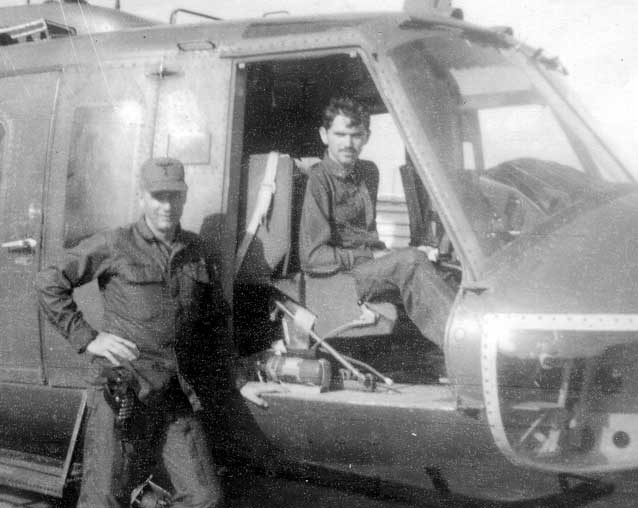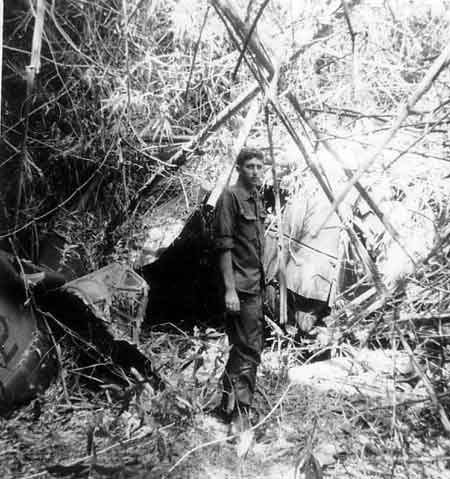Tragic Day for the Thunderbirds
October 9, 1969
To borrow and word, October 9, 1969 was a day that will live in "infamy" in the history of the 118th Thunderbirds. October 9, 1969 was a terrible day because of the loss of 6 Thunderbird lives and 5 men from the 199th Light Infantry Brigade.On October 9, 1969, a UH1D (63-08826) helicopter crew and 5 passengers were in the last aircraft of a flight of Thunderbird aircraft executing an extraction from a mined PZ (pick-up zone) in eastern Long Khanh Province, South Vietnam. The PZ was very near the shores of the swiftly flowing Song Dong Nai River. During the extraction, the heavily loaded helicopter's main rotor blades clipped some 45 feet tall bamboo while struggling out of the PZ as formation trail. The helicopter, already struggling with low rotor RPM began losing altitude. It turned right and headed west over the river in an attempt to regain air speed. Shortly thereafter, the aircraft commander, CW 4 James A. Bailey was forced to make a textbook water landing in 15-20 feet of water. The UH-1D sank on its left side in less than 10 seconds according to reports.
Continuous air and water searches were conducted immediately after the crash. They resulted in the rescue of two crew members, WO1 Steven. T. Kilbourne and SP4 O. Cowherd. None of the 5 passengers could be rescued and all perished! For days after that, loudspeaker broadcasts, and leaflet distributions to the locals were conducted. These took place during the periods of 9-15 October and 19-21 October, 1969. They were finally suspended October 16-18, 1969 only because of poor weather conditions. Recovery of most of the missing personnel aboard was accomplished. However, 5 were never recovered and classed as BNR.
A LRRP swimmer trying to search the site had difficulty working in the swift waters of the Song Dong Nai river, even with a rope. The individual reported that equipment was seen on the shore after the crash and it appeared to be alternately submerged and then to reappear. It could not be determined immediately how many persons escaped the aircraft. One who did escape reported that he could not make it to shore and went under numerous times. Another survivor reported seeing a man go down within 3-4 feet of him, but never saw him again. One of the individuals who was initially thought to have survived, later drowned or was lost in the incident.
The only survivors of the crash of UH-1D (63-08826) was WO1 Steven T. Kilbourne, the young pilot and the Crew Chief SP4 O. Cowherd. The two crew member remains located were identified as the crew chief, who had survived the immediate crash, but later drowned, and CW4 James W. Bailey, the aircraft commander, who was lost and remains recovered. However, the gunner SP5 James Henry Turner, was presumed drowned and he eventually classified as BNR.
The waters of the Song Dong Nai River were swift and treacherous that day apparently due to monsoon rains. It is particularly tragic that men who survived an aircraft crash would then drown trying to reach safety or aid others who were passengers. SGT James Lawrence Suydam, SGT Dallas Alan Driver, SGT Jimmy Ray Garbett, SGT Raymond Gregory Moore and SP5 James Henry Turner were listed as Killed, Body Not Recovered (BNR).The fact that so many 199th Light Infantry Bde. Sergeants died in the last aircraft out of the PZ should not go unnoticed. Typically when a unit on the ground was extracted from a PZ, the unit places many Claymore mines around the PZ and then detonates them as the last men load on the aircraft to leave. These Sergeants did just that and were the last to leave the PZ and the ones to detonate the Claymore mines. True leaders and men doing the job of heros.  CW4 James A. Bailey, leaning against the aircraft before the incident. CW4 Bailey, a very experienced US Army Aviator,at the age of 42, died tragically with 6 others when his aircraft crashed and sank into the Song Dong Nai River.The pilot in the aircraft seat is Lawrence B. Smith, who was given this photo the day before the tragic crash.(69)(Photo courtesy Lawrence B. Smith)===========
CW4 James A. Bailey, leaning against the aircraft before the incident. CW4 Bailey, a very experienced US Army Aviator,at the age of 42, died tragically with 6 others when his aircraft crashed and sank into the Song Dong Nai River.The pilot in the aircraft seat is Lawrence B. Smith, who was given this photo the day before the tragic crash.(69)(Photo courtesy Lawrence B. Smith)===========
A Bandit Crew Unfound for Days!
October 9, 1969
While supporting troops in heavy combat at coordinates YT 3025, about 7 miles East of Bien Hoa on October 9, 1969, Bandit 2, a UH-1C (66-00530) gun ship, was lost for days when it crashed in tall bamboo in bad weather. Bandit 2 with the bodies of the 4 killed crew members on board, was not found for many days afterward. Apparently, some Vietnamese wood cutters found the aircraft in thick bamboo, completely covered (See photos below).According to the accident summary, Bandit 2, piloted by Aircraft Commander CW2 Owen Tetsumi Hirano, and Pilot 1LT Robert Scott Mason, Jr. and Crew Chief SP5 Greg Bradford Scott and Gunner SP4 Danny Ray Spencer, was flying wing with 1LT John W. Mack who was the fire-team leader of the light fire-team. CW2 Hirano's aircraft had a 20 minute fuel warning light on. It was dark and both aircraft experienced lost contact with the ground and began flying on instruments in very poor weather. They were within 500-600 feet above the jungle tops. They both new this was in the vacinity of the high tension power lines that followed Highway 1. CW2 Hirano called Lt. Mack and told him he had Highway 1 in sight with his search light and would pick it up and follow it back to Bien Hoa. 1LT Mack followed CW2 Hirano and shortly after passing over Trang Bom they ran into extremely heavy rain and went completely IFR. CW2 Hirano called and said he was making a 180 degree turn to the right. They both turned right and LT Clay A. Hinderliter, co-pilot with LT Mack, lost sight of CW2 Hirano's aircraft. LT Mack's aircraft made it back to Trang Bom and landed. They tried repeatedly to contact CW2 Hirano's aircraft by FM, UHF and VHF radios, but no contact.After about 20 minutes on the ground at Trang Bom, the weather cleared sufficiently to take-off. LT Mack and LT Hinderliter took off and proceeded the short distance to Bien Hoa, but CW2 Hirano was not there. A search was conducted for many days, without success. However, following an intelligence report that some Vietnamese woodcutters had found an aircraft crashed in thick bamboo, the aircraft was finally found. SP5 Dan Chase, Crew Chief of a 145th CAB, HQ,aircraft, standing beside Bandit 2 wreckage,which was lost for days in thick bamboo.(69)(Photo courtesy Dan Chase)
SP5 Dan Chase, Crew Chief of a 145th CAB, HQ,aircraft, standing beside Bandit 2 wreckage,which was lost for days in thick bamboo.(69)(Photo courtesy Dan Chase)  A closer photo showing the "2" of Bandit 2 vertical stabilizer, above.(69)(Photo courtesy Dan Chase)
A closer photo showing the "2" of Bandit 2 vertical stabilizer, above.(69)(Photo courtesy Dan Chase)



No comments:
Post a Comment